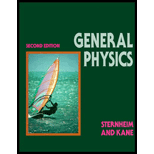
Concept explainers
(a)
The ratio of distance to the radius of a hydrogen atom.
(a)
Answer to Problem 86E
The ratio of distance to the radius of a hydrogen atom is
Explanation of Solution
Given that the charge of an electron is
Write the expression for the dipole moment.
Here,
Solve Equation (I) for
Conclusion:
Substitute
The ratio of the distance to the radius of a hydrogen atom is,
Therefore, the ratio of distance to the radius of a hydrogen atom is
(b)
The energy needed to flip the dipole.
(b)
Answer to Problem 86E
The energy needed to flip the dipole is
Explanation of Solution
Given that the electric field is
The energy required to flip the dipole can be measured by using
Here,
Conclusion:
Substitute
Therefore, the energy needed to flip the dipole is
(c)
The implication average kinetic energy of a molecule for the orientation of water molecule in the relatively strong field of
(c)
Answer to Problem 86E
The value of the
Explanation of Solution
Given that the average kinetic energy of the molecule is
Let the angle
Conclusion:
Substitute
Therefore, the value of the
Want to see more full solutions like this?
Chapter 16 Solutions
General Physics, 2nd Edition
- Two thin conducting plates, each 25.0 cm on a side, are situated parallel to one another and 5.0 mm apart. If electrons are moved from one plate to the other, what is the electric field between the plates?arrow_forwardA water molecule consists of two hydrogen atoms bonded with one oxygen atom. The bond angle between the two hydrogen atoms is 104( (see below). Calculate the net dipole moment of a water molecule that is placed in a uniform, horizontal electric field of magnitude 2.3108N/C . (You are missing some information for solving this problem; you will need to determine what information you need, and look it up.)arrow_forwardA uniform electric field E = 3 000 V/m exists within a certain region. What volume of space contains an energy equal to 1.00 107 J? Express your answer in cubic meters and in liters.arrow_forward
- A charge q=2.0C is released from rest when it is 2.0 m from a fixed charge q=6.0C . What is the kinetic energy of q when it is 1.0 m from Q?arrow_forwardA water molecule is made up of two hydrogen atoms and one oxygen atom, with a total of 10 electrons and 10 protons. The molecule is modeled as a dipole with an effective separation d = 3.9 1012 m between its positive and negative particles. What is the electric potential energy stored in the dipole? What does the sign of your answer mean?arrow_forwardA set of parallel plates has a capacitance of 5.0F . How much charge must be added to the plates to increase the potential difference between them by 100 V?arrow_forward
- In a certain region of space, the electric field is E = 6.00 103 x2i, where E is in newtons per coulomb and x is in meters. Electric charges in this region are at rest and remain at rest. (a) Find the volume density of electric charge at x = 0.300 m. Suggestion: Apply Gausss law to a box between x = 0.300 m and x = 0.300 m + dx. (b) Could this region of space be inside a conductor?arrow_forwardA 6.50-F capacitor is connected to a battery. What is the charge on each plate of the capacitor if the voltage of the battery is a. 10.0 V and b. 2.00 V?arrow_forwardWhat are the stable orientation(s) for a dipole in an external electric field? What happens if the dipole is slightly peltulbed from these orientations?arrow_forward
- A charge of 36.3 nC is transferred to a neutral copper ball of radius 4.35 cm. The ball is not grounded. The excess electrons spread uniformly on the surface of the ball. What is the number density (number of electrons per unit surface area) of excess electrons on the surface of the ball?arrow_forwardHow many coulombs of positive charge are there in 4.00 kg of plutonium given its atomic mass is 244 and that each plutonium atom has 94 protons?arrow_forwardAn electric potential exists in a region of space such that V = 8x4 2y2 + 9z3 and V is in units of volts, when x, y, and z are in meters. a. Find an expression for the electric field as a function of position. b. What is the electric field at (2.0 m, 4.5 m, 2.0 m)?arrow_forward
 Physics for Scientists and Engineers: Foundations...PhysicsISBN:9781133939146Author:Katz, Debora M.Publisher:Cengage Learning
Physics for Scientists and Engineers: Foundations...PhysicsISBN:9781133939146Author:Katz, Debora M.Publisher:Cengage Learning
 Physics for Scientists and Engineers, Technology ...PhysicsISBN:9781305116399Author:Raymond A. Serway, John W. JewettPublisher:Cengage Learning
Physics for Scientists and Engineers, Technology ...PhysicsISBN:9781305116399Author:Raymond A. Serway, John W. JewettPublisher:Cengage Learning Principles of Physics: A Calculus-Based TextPhysicsISBN:9781133104261Author:Raymond A. Serway, John W. JewettPublisher:Cengage Learning
Principles of Physics: A Calculus-Based TextPhysicsISBN:9781133104261Author:Raymond A. Serway, John W. JewettPublisher:Cengage Learning Glencoe Physics: Principles and Problems, Student...PhysicsISBN:9780078807213Author:Paul W. ZitzewitzPublisher:Glencoe/McGraw-Hill
Glencoe Physics: Principles and Problems, Student...PhysicsISBN:9780078807213Author:Paul W. ZitzewitzPublisher:Glencoe/McGraw-Hill




